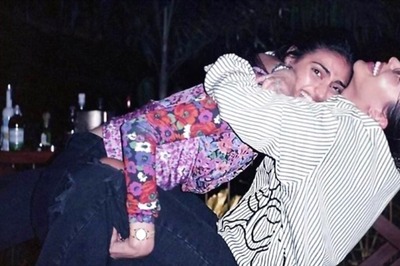
views
“There are three things all wise men fear: the sea in a storm, a night with no moon, and the anger of a gentleman” — Patrick Rothfuss, The Wise Man’s Fear.
The Bengali gentleman, a.k.a. the “Bhadralok”, is back on his feet after what seemed like a long socio-political numbness and withdrawal that apparently threatened to decimate his innate propensity to question anarchy and stand up against injustice – qualities which have always been integral to the “Bengali ethos”.
The junior doctors of Bengal’s medical colleges have successfully stoked the near-extinguished fire and have transformed it into raging flames that now rightfully attempt to burn down monuments built on an edifice of corruption and unscrupulousness, constructed with bricks of political connivance and cemented by the nefarious yet artful manoeuvres of a handful of enslaved, invertebrate bureaucrats.
The Bengali conscience has been systematically stabbed time and again by several scams in the education and food sectors over the past few years. The rape and murder of Abhaya (name changed), it seems, became the last straw, compelling the entire state to rise up in an unprompted, spontaneous gesture against this heinous crime committed on the premises of a government medical college. This uprising made it clear to the administration that enough is enough!
Bengal is no longer prepared to lie down and take it. The state has once again risen to the occasion to restore the vision of Bengal that Tagore himself dreamed of—”where the mind is without fear and the head is held high.”
Let’s examine the events and circumstances following the rape and murder of Abhaya, a PGT in the Department of Chest Medicine, that led to this mass uprising in Bengal, now reverberating across the state and the entire country.
August 9
On August 9, a 31-year-old post-graduate trainee doctor was found dead in a semi-naked condition on the fourth floor of the seminar hall at the state-run RG Kar Medical College and Hospital. The medical examination revealed that the victim had sustained both external and internal injuries during the sexual assault and was subsequently murdered. Shockingly, no FIR was filed for 14 hours.
August 10
The Kolkata police arrested the accused, civic volunteer Sanjay Roy, after his “prolonged examination and confession of guilt.” This was when the first protest by doctors erupted across West Bengal, prompting Chief Minister Mamata Banerjee to vow to seek the death penalty for the assailant.
August 11
The West Bengal government transferred the Superintendent of RG Kar Medical College, Sanjay Vashisth, over alleged lapses in handling the case. The Federation of Resident Doctors Association (FORDA) announced its support for the agitation, calling for a nationwide strike and a halt to elective services.
August 13
The Calcutta High Court took cognisance of the case, describing it as “extremely gruesome” and urged the protesting doctors to resume services. The National Human Rights Commission also took suo motu cognisance. The Court ordered the former RG Kar Principal to take extended leave and transferred the case to the CBI, citing a lack of progress. The CBI subsequently arrested the accused.
August 15
On August 15, a mob stormed the state-run hospital, vandalising the emergency department and nursing station at RG Kar Medical College and Hospital. The Indian Medical Association (IMA) called for a nationwide withdrawal of services for 24 hours on August 17.
August 16
Police arrested over 19 people on charges of vandalism.
August 17
The National Commission for Women (NCW) alleged security lapses and tampering of evidence, while the IMA sought the prime minister’s intervention. The Health Ministry vowed to form a committee to address security concerns for healthcare professionals and urged them to resume their duties.
August 18
The Supreme Court took suo motu cognisance of the incident and scheduled a hearing for August 20.
August 19
Sandip Ghosh was questioned by the CBI for the fourth consecutive day. The probe agency was granted permission to conduct a polygraph test on the accused.
August 20
A Supreme Court bench led by Chief Justice DY Chandrachud constituted a 10-member task force to formulate a national protocol to ensure the safety and security of doctors. The Court also directed the state government and Kolkata Police to submit a status report.
August 21
The Centre directed the CISF to take over security at the state-run hospital. Meanwhile, Kolkata Police suspended three officers over the vandalism incident.
August 25
The CBI raided the residences of former RG Kar Medical College and Hospital Principal Sandip Ghosh, ex-MSVP Sanjay Vashisth, and 13 others.
September 10
Protesting junior doctors turned down the West Bengal government’s invitation for talks.
September 11
The state government rejected the junior doctors’ demands for Chief Minister Mamata Banerjee’s presence and a live broadcast of the talks.
September 14
The CBI arrested former RG Kar Principal Sandip Ghosh and a Kolkata police officer over delays in the registration of the FIR and missing evidence.
How a doctors’ protest metamorphosed into an apolitical people’s uprising that changed the trajectory of history: Bengal shows the way, once again
Abhaya was tragically fated for this cataclysmic tempest of Bengal against injustice and crime. However, the peaceful citizens’ protests that followed her rape and murder on the premises of RG KAR Hospital – protests which refuse to die down even after 45 days since the heinous incident – have become a torchbearer for the rest of the country due to the several “firsts” this protest has accomplished.
One, an important characteristic of this movement is its unprecedented spontaneity—people have taken to the streets of Bengal in protest, shunning all attempts at intimidation and the state’s intent to defang the uprising. Through non-violent, collaborative movements and marches like “Raat Dokhol” or “Seize the Night,” spearheaded by researcher Rimjhim Sinha and spread via social media, common people, especially women, have joined in staggering numbers. This has astonished political pundits and the entire country with both the depth (the sheer number of people joining the street protests) and the magnitude of its reach (spanning unimaginable locations, transcending urban centres, and spreading into the most rural areas and innermost pockets of the state).
Two, another significant characteristic of this protest is its unanimity in the demand for justice and safety for women. The focus has been clear from the outset and remains unchanged even as the citizens’ protests enter their seventh week. While junior doctors have resumed duty in state hospitals after many of their demands were met by the state, the people’s call for justice continues.
Three, people from all strata of society – from the elite to the pedestrian, from cloistered castle inhabitants to vulnerable street dwellers, from the middle classes to students of schools and colleges, from nondescript rickshaw pullers and food delivery workers to celebrated Tollywood actors, poets, painters, public figures, writers, and theatre artists across the state – have come out and wholeheartedly participated in these peaceful protests. This diverse participation has compelled political scientists to take note of this unique, single-point uprising that has united everyone against injustice.
Four, another important aspect of this movement for justice has been its apolitical nature throughout. The junior doctors, as well as civil society, have steered clear of political insinuations and preserved this uprising from being hijacked by any political outfit, thus honouring the sanctity of both the departed Abhaya and the tireless movement that demands justice for her.
In other words, Bengal has once again shown the rest of the country how a unified, apolitical movement can awaken a state’s collective consciousness. It has channelled unified rage, common dissent, and shared disenchantment with the political system into a mass movement that has – non-violently but uncompromisingly – compelled those occupying the highest echelons of power in the state to finally extend an olive branch and meet the junior doctors halfway.
Why Politics Was Deliberately Kept Out and What It Reflects About the Bengali Mindset at the Moment
Bengal is wounded. Enough is enough. Over the last decade, successive cases of corruption and threats to women’s safety have shaken the very foundations of Bengali confidence and faith in the system. Abhaya’s case was the final straw. The average Bengali has seen through the hidden agendas of political outfits and parties across the spectrum, all of which seem to have an axe to grind, even in their proclaimed support for the protests demanding justice for Abhaya.
The outcry now reverberating through the streets of Bengal, threatening to tear apart the shams of normalcy, is the roar of a wounded tiger, finally rising to reclaim its fate after being repeatedly attacked by the hyenas of corruption, anarchy, and absolutism.
The leaders of this uprising—junior doctors, fully supported by all sections of society—have been extremely vigilant in ensuring that no political colour contaminates the essence of this powerful movement, which still has many more milestones to achieve.
Recent Update of Events and the Way Forward
On 16 September 2024, CM Mamata Banerjee met the demands of the protesting doctors and announced that the Kolkata Police Commissioner, Vineet Kumar Goyal, the Deputy Commissioner of Kolkata Police (North), and two senior officials of the Health Department would be replaced. The junior doctors hailed this decision as a major victory and a landmark in their 38-day-long protests, demanding justice for their 31-year-old deceased colleague.
However, the doctors stated that they expect the assurances to be implemented and will resume services only after consulting with protesting doctors from other hospitals. This development followed a meeting between the chief minister and a delegation of about 40 doctors at her residence.
On 17 September, the Supreme Court described the revelations in the CBI’s status report as “disturbing” while hearing the suo motu case concerning the rape and murder of the postgraduate doctor at Kolkata’s RG Kar Medical College and Hospital. A three-judge Bench, led by Chief Justice of India (CJI) D.Y. Chandrachud, chose not to disclose the specifics of the report, citing concerns that such revelations could compromise the ongoing investigation. The CJI noted that the CBI is examining several possibilities, including potential tampering with the crime scene, involvement of additional individuals beyond the two accused, and evidence tampering.
The Bench also directed Wikipedia to remove information disclosing the victim’s identity. Additionally, the judges emphasised that the West Bengal government could not restrict women doctors from working night shifts or exceeding 12-hour shifts as part of the proposed reforms. “Women do not want concessions, only equal opportunities,” said the Chief Justice. “Instead of restricting women doctors’ hours, the WB government should focus on ensuring their safety,” the CJI stressed.
Why is Justice the Keystone to Restoring Peace and Order in Bengal’s Social Life?
“Injustice anywhere is a threat to justice everywhere,” wrote Martin Luther King Jr. in his Letter from a Birmingham Jail, noting that we are all interconnected and what affects one person affects all.
Both retributive and restorative justice are required for corrective measures to be undertaken. This will address grievances and put the derailed train of social democracy back on the right track. Heinous crimes like rape and murder call into question the very existence of law within the state. They undermine justice in the most unabashed and brutal manner, posing a grave threat to the very foundation upon which our democracy stands and functions.
Fear of punitive justice is necessary to deter such deplorable crimes from recurring. Therefore, the whole of Bengal now looks to the apex court for a resolution in Abhaya’s case that sets an example for both the legal system and society at large. This verdict must act as a powerful deterrent against any future defiance of the law, by anyone.
“If you want peace, work for justice,” declared Pope Paul VI in his 1972 Day of Peace message. These words resonate deeply with a parched and injured Bengali consciousness yearning for a torrential downpour of justice for Abhaya.
Possible Future of This Spontaneous People’s Movement: Lessons Learnt
When the people decide to take a stand, there is nothing they cannot achieve collectively. It was the united will of Bengal that compelled the state government to back down against the non-violent protesting doctors and swallow its misplaced pride by agreeing to the demands put forth by the junior doctors. However, there is still a long way to go.
The Bengali proletariat has rightfully reclaimed its spine and continues to stand up against a system that still threatens to use state agencies and their absolute power to intimidate and undermine the movement. Case in point: within 24 hours of doctors ending their protests and rejoining work in their respective state hospitals, notices were sent to the key individuals spearheading the “seize the night” or “raat dokhol” protests held at midnight on the eve of Independence Day, 14 August 2024. The fear of orchestrated arrests aimed at blunting the ongoing citizens’ movement looms large.
The CBI is walking on thin ice as it attempts to uncover the minutest specks of evidence – unfortunately already tampered with to some extent – related to the mystery encompassing the rape and murder of Abhaya. They will likely face an uphill battle to get to the crux of the conundrum. The investigation is ongoing, and as the matter is sub-judice, it is prudent and ethical to await the court’s decision and interpretation.
The state is on overdrive to wipe out all memories connected with this unprecedented people’s uprising. The prelude has involved erasing all graffiti and symbols connected with the uprising, though its flames refuse to diminish, far from dying a premature death. In response, one of the leaders of the junior doctors’ protests, Dr Kinjal Nanda, rightly pointed out that the state can use its machinery to wipe out physical impressions and symbols but can hardly erase the deep imprints that this heinous crime and the subsequent people’s movement have made upon the canvas of the Bengali conscience.
Echoing the truth of Dr Nanda’s contention, on Sunday evening, citizens of Kolkata once again rose in unison. Through peaceful marches and demonstrations in different parts of the city, they protested the subversive mechanisms of intimidation and repression being applied by the state against the architects of this citizens’ uprising.
The Bengali mindset has now resolved to rediscover its lost voice and refuses to back down or compromise any longer.
Nothing less than justice is acceptable now, and nothing more than focused intention is required to pull Bengal out of this shameful situation. That is the heartfelt cry of every Bengali, and it certainly seems they are in no mood to relent or give up until justice is served, in every sense of the word.
Over the past few years, one of the three pillars of democracy – justice – has been perpetually subverted. This is especially true in matters of women’s safety and spine-chilling cases of cruelty against women, where political connivance has shielded those with vested interests. The result has been a debilitating hypnosis descending upon the Bengali consciousness.
The everyday Bengali chose to swallow the bitter pill of injustice for so long, not because they were unaware of their rights, but because they clung to the belief that goodness would eventually prevail. Alas, it took a tragedy like Abhaya’s to finally shatter this immense patience and faith in the political system. This devastating loss unshackled them from the chains of complacency and blind faith, pulling them out of their passive state.
Today, Bengal has a unanimous demand: Justice for Abhaya. This verdict must set a precedent, proving to all detractors that a woman will no longer be a victim of fear, lust, or harassment—not in her home, at her workplace, on the streets, in public places, or any place she chooses to be, day or night. An attack on a woman’s dignity will be met with severe consequences, both socially and legally.
Bengal, the rest of India, the rest of the world—all eyes now turn to the Supreme Court, hoping for the deliverance of ultimate justice for Abhaya’s departed soul. This is a watershed moment in Bengal’s socio-political history.
Debaroopa Bhattacharyya is founder and editor-in-chief of Tribe Tomorrow Network. Views expressed in the above piece are personal and solely that of the author. They do not necessarily reflect News18’s views.




















Comments
0 comment